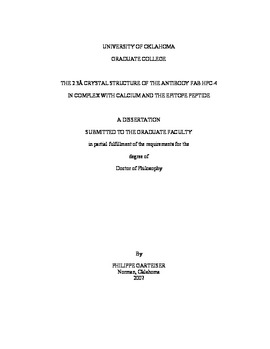| dc.contributor.advisor | Mather, Timothy, | en_US |
| dc.contributor.advisor | Nollert, Matthias U., | en_US |
| dc.contributor.author | Garteiser, Philippe. | en_US |
| dc.date.accessioned | 2013-08-16T12:20:39Z | |
| dc.date.available | 2013-08-16T12:20:39Z | |
| dc.date.issued | 2007 | en_US |
| dc.identifier.uri | https://hdl.handle.net/11244/1189 | |
| dc.description.abstract | The murine monoclonal antibody HPC-4, directed against the activation region of the human anticoagulant zymogen protein C (PC), is one of the few immunoglobulins known to display calcium-dependent antigen binding. Unlike the more common class of antibodies that merely recognize a calcium-bound conformation of their antigen, HPC-4 interacts directly with calcium in the high affinity PC-HPC-4 complex. | en_US |
| dc.description.abstract | Metal ions can have considerable affinities for proteins, and give rise to geometric constraints that are often taken advantage of in protein-protein interactions. The coordination shell of metal ions can be filled by atoms provided by two different proteins, resulting in a high affinity protein complex. Surprisingly, this highly efficient binding strategy is rarely observed in immunoglobulins, despite the great number of known antibody structures determined in complex with their protein antigens. | en_US |
| dc.description.abstract | The structure reveals a mode of calcium binding which underlies a novel mechanism of metal aided antigen recognition. The ion is located at the antibodyantigen interface, where it functions both as an electrostatic bridge and as a conformational effector of the antibody. The antigen is further stabilized by an extensive and diverse array of interactions spanning a large surface area of contact. Our results provide a structural explanation for many of the observed characteristics of HPC-4, the first member of a unique class of calcium binding antibodies. As such, it represents a significant contribution to the study of interfacial metals and the structural biology of antibodies. | en_US |
| dc.description.abstract | To provide a structural understanding of HPC-4 function and of the particular antibody class to which it belongs, we have solved the X-ray crystal structure of the HPC-4 Fab fragment in ternary complex with its epitope peptide in the presence of calcium at a resolution of 2.3A. Within the crystal, the antigen-binding region is undistorted by crystalline lattice contacts. All complementarity-determining regions and the peptide antigen have well-defined electron density. | en_US |
| dc.format.extent | vi, 137 leaves : | en_US |
| dc.subject | Immunoglobulins. | en_US |
| dc.subject | Engineering, Biomedical. | en_US |
| dc.subject | Metal ions. | en_US |
| dc.subject | Antigen-antibody reactions. | en_US |
| dc.title | The 2.3A crystal structure of the antibody Fab HPC-4 in complex with calcium and the epitope peptide. | en_US |
| dc.type | Thesis | en_US |
| dc.thesis.degree | Ph.D. | en_US |
| dc.thesis.degreeDiscipline | School of Chemical, Biological and Materials Engineering | en_US |
| dc.note | Advisers: Matthias U. Nollert; Timothy Mather. | en_US |
| dc.note | Source: Dissertation Abstracts International, Volume: 68-04, Section: B, page: 2481. | en_US |
| ou.identifier | (UMI)AAI3261112 | en_US |
| ou.group | College of Engineering::School of Chemical, Biological and Materials Engineering | |
